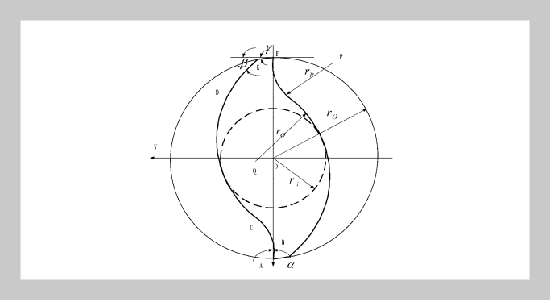REFERENCES
- [1] Wu, C. T. and Chen, C. K., “Study on Rotating Cutters with Different Definitions of Helical Angle,” International Journal of Advanced Manufacturing Technology, Vol. 17, pp. 627�638 (2001).
- [2] Chen, W. F., Lai, H. Y. and Chen, C. K., “A Precision Tool Model for Concave Cone-End Milling Cutters,” Advanced Manufacturing Technology, Vol. 18, pp. 567�578 (2001).
- [3] Kaldor, S., Trendler, P. H. H. and Hodgson, T., “Investigation into the Clearance Geometry of End Mills,” Annals of the CIRP, Vol. 33, pp. 133�139 (1984).
- [4] Kaldor, S., Trendler, P. H. H. and Hodgson, T., “Investigation and Optimization of the Clearance Geometry of End Mills,” Annals of the CIRP, Vol. 34, pp. 153� 159 (1985).
- [5] Kang, S. K., Ehmann, K. F. and Lin, C., “A CAD Approach to Helical Groove Machining Mathematical Model and Model Solution,” Int. J. Mach. Tools Manufact, Vol. 36, pp. 141�153 (1996).
- [6] Chen, W. F., Lai, H. Y. and Chen, C. K., “Design and NC Machining of Concave-Arc Ball-end Milling Cutters,” Advanced Manufacturing Technology, Vol. 20, pp. 169�179 (2002).
- [7] Chen, C. K., Lai, H. Y. and Tang, Y., “A Manufacturing Model of Carbide-Tipped Spherical Milling Cutters,” Proc. Inst. Mechanical Engineers. Part B, Vol. 213, pp. 713�724 (1999).
- [8] Chen, W. F. and Chen, W. Y., “Design and NC Machining of a Toroid-Shaped Revolving Cutter with a Concave Arc Generator,” Journal of Materials Processing Technology, Vol. 121, pp. 217�225 (2002).
- [9] Kang, S. K., Ehmann, K. F. and Lin, C., “A CAD Approach to Helical Flute Machining Mathematical Model and Model Solution,” Int. J. Mach. Tools Manufact, Vol. 36, pp. 141�153 (1996).
- [10] Wu, C. T., Chen, C. K. and Tang, Y. Y., “Modeling and Computer Simulation of Grinding of the Ball End Type Rotating Cutter with a Constant Helical Angle,” Proceedings of the Institution of Mechanical Engineers, Part B: Journal of Engineering Manufacture, Vol. 215, pp. 1�14 (2001).
- [11] Tsai, Y. C. and Hsieh, J. M., “A Study of a Design and NC Manufacturing Model of Ball-End Cutters,” Journal of Materials Processing Technology, Vol. 117, pp. 183�192 (2001).
- [12] Chen, W. F., Lai, H. Y. and Chen, C. K., “Design and NC Machining of Concave-Arc Ball-End Milling Cutters,” Advanced Manufacturing Technology, Vol. 20, pp. 169�179 (2002).
- [13] Chen, W. Y., Wang, J. C. and Chen, W. F., “A Precision Design and NC Machining of Circular-Arc End-Milling Cutters,” Journal of Materials Processing & Manufacturing Science, Vol. 10, pp.45�67 (2001).
- [14] Chen, W. F., “A Precision Design for Computer Numerical Machining Models of Involute-Generator Revolving Cutters,” Proceedings of the Institution of Mechanical Engineers Part B-Journal of Engineering Manufacture, Vol. 218, pp. 517�531 (2004).
- [15] Chen, W. Y., Chang, P. C., Liaw, S. D. and Chen, W. F., “A Study of Design and Manufacturing Models for Circular-Arc Ball-End Milling Cutters,” Journal of Materials Processing Technology, Vol. 161(3), pp. 467�477 (2005).
- [16] Chen, W. F., “A Mathematical Solution to the Design and Manufacturing Problems of Ball-End Cutters having a Cutting Edge with Constant Angle to the Axis,” Journal of Mechanical Engineering Science Proceedings of the Institution of Mechanical Engineers Part C, Vol. 218, pp. 301�308 (2004).
- [17] Lai, H. Y. and Chen, W. F., “Precision Design and Numerical Control Machining of Tapered Ball-End Milling Cutters,” Proceedings of the Institution of Mechanical Engineers Part B-Journal of Engineering Manufacture, Vol. 216, pp. 183�197 (2002).
- [18] Chen, W. Y., Wang, J. C. and Chen, W. F., “A Precision Design and NC Machining of Circular-Arc End-Milling Cutters,” Journal of Materials Processing & Manufacturing Science, Vol. 10, pp. 45�67 (2001).
- [19] Lin, S. W., “Study on the 2-Axis NC Machining of a Toroid-Shaped Cutter with a Constant Angle between the Cutting Edge and the Cutter Axis,” Journal of Materials Processing Technology, Vol. 115, pp. 338�343 (2001).
- [20] Lin, S. W. and Lai, H. Y, “A Mathematical Model for Manufacturing Ball-End Cutter Using A Two-Axis NC Machine,” The International Journal of Advanced Manufacturing Technology, Vol. 17, pp. 881� 888 (2001).
- [21] Chen, C. K. and Lin, R. Y., “A Study of Manufacturing Models for Ball-End Type Rotating Cutters with Constant Pitch Helical Grooves,” International Journal of Advanced Manufacturing Technology, Vol. 18, pp. 157�167 (2001).
- [22] Ren, B. Y., Tang, Y. Y. and Chen, C. K., “The General Geometrical Models of the Design and 2-Axis NC Machining of a Helical End-Mill with Constant Pitch,” Journal of Materials Processing Technology, Vol. 115, pp. 265�270 (2001).
- [23] Wu, C. T. and Chen, C. K., “Manufacturing Models for the Design and NC Grinding of a Revolving Tool with a Circular Arc Generatrix,” Journal of Materials Processing Technology, Vol. 116, pp. 114�123 (2001).
- [24] Yan, H. S. and Lin, J. Y., “Geometric Design and Machining of Variable Pitch Lead Screws with Cylindrical Meshing Elements,” Trans. of the ASME, J. of Mech. Des, Vol. 115, pp. 490�495 (1993).
- [25] Lai, H. Y., “A High-Precision Surface Grinding Model for General Ball-End Milling Cutters,” Advanced Manufacturing Technology, Vol. 19, pp. 393�402, (2002).
- [26] Engin, S. and Altintas, Y., “Mechanics and Dynamics of General Milling Cutters Part I: Helical End Mills,” Machine Tools & Manufacture, Vol. 41, pp. 2195� 2212 (2001).
- [27] Engin, S. and Altintas, Y., “Mechanics and Dynamics of General Milling Cutters Part II: Inserted Mills,” Machine Tools & Manufacture, Vol. 41, pp. 2213�2231 (2001).
- [28] Kaldor, S., Rafael, A. M. and Messinger, D., “On the CAD of Profiles for Cutters and Helical FlutesGeometrical Aspects,” Ann. of the CIRP, Vol. 37, pp. 53�57 (1988).
- [29] Sheth, D. S. and Malkin, S., “CAD/CAM for Geometry and Process Analysis of Helical Groove Machining,” Annals of the CIRP, Vol. 39, pp. 129�132 (1990).
- [30] Kang, S. K., Ehmann, K. F. and Lin, C., “A CAD Approach to Helical Groove Machining Mathematical Model and Model Solution,” Int. J. Mach. Tools Manufacture, Vol. 36, pp. 141�153 (1996).
















